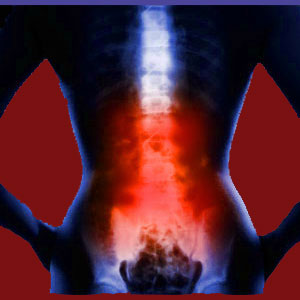
Facet joint lower back pain is the most often reported location for symptoms in the spinal anatomy. The lumbar spine typically suffers more degeneration than other spinal zones and this fact includes deterioration of the protective measures within the zygapophyseal joints. Lumbar facet hypertrophy and general facet joint arthritis affect the majority of people past middle age; but fortunately, most cases are not overly symptomatic, if painful at all. However, for patients who do experience severe facet syndrome in the lower back, symptoms can be agonizing and very physically-limiting. Most patients will not be capable of bending forward and will be restricted in their ability to lift, sit and perform many basic tasks. Lumbar symptoms are always some of the most debilitating, regardless of the diagnosis rendered.
This treatise explores lower back pain that might be created by facet syndrome. We will provide information on the typical location and expression of these lumbar dorsalgia syndromes, as well as helpful tips for patients who are currently seeking diagnostic or treatment recommendations.
Facet Joint Lower Back Pain Locations
The lower back consists of 5 lumbar vertebrae and the juncture with the sacrum. Facet joint degeneration is usually most noticeable at the same levels as the other spinal aging process in the lower back, namely L4, L5 and S1. These are the locations that feature the earliest signs of spinal deterioration in most people, with visible changes being present in most people by their mid to late 20s. Some patients demonstrate upper lumbar facet joint changes instead of the more common lower levels. Usually, these structural alterations are seen at the frontier of the thoracic spine, called the thoracolumbar juncture of T12/L1.
The lumbar spine must support most of the body’s weight, as well as provide upright posture and tremendous flexibility through endless types of motion. The lumbar spine is constantly working, except when reclining to rest or sleep. Even sitting upright provides a very good workout, as does standing, walking and doing virtually anything physically at all. All of this stress takes a heavy toll on the spinal discs of the lumbar region. These are the first to show wear and tear in the backbone anatomy. Desiccation and herniation are virtually universal, typically by the age of 30. Subsequently, osteoarthritis sets in, impacting the lumbar region in the traditional way, inciting bone spurring, as well as the resulting spinal joint changes, narrowing of the central spinal canal and reduction in patency in the neuroforaminal openings.
Lower Back Pain Symptoms
Lower back pain is considered to be one of the worst types of dorsalgia by clinicians. Pain scale ratings are often off the chart and are truly debilitating. Fortunately, facet joint pain is the exception to that rule, being tolerable in most instances. Let’s examine the typical symptomatic expressions based on the type of facet pathology displayed:
Facet bone spurring can cause mechanical pain in the joint, usually upon movement. In rare cases, osteophytes might cause hypomobility of the joint and extremely painful movement, if any is at all possible. Joint fusion is possible in the worst cases, limiting range of motion, but sometimes helping to decrease pain once the joint truly freezes.
When the small nerves inside the facet joint are encroached upon and compressed, pain will likely be sharp and limited to times of movement. Pain might fade episodically to paresthesia with a tight feeling in the joint. Tingling sensations are also common, even when the region is not painful.
Both of the above scenarios should involve symptoms that are expressed over the spine itself and pain that will not radiate far from its source. Bending the affected joints of the spine is the most common instigator of pain.
Ligament problems might affect the tension of the facet joints and may or may not be painful. If pain is present, it might be widespread, typically following the contour of the spine and may affect more than one joint.
When osteophytes reduce the patency of the lumbar foraminal openings, then a pinched nerve might result. In this scenario, pain may or may not be present at the site of compression, but symptoms will likely exist at the innervated locations in the buttocks, legs and/or feet. These symptoms are called sciatica and might involve pain, tingling, numbness, burning or weakness in select areas, usually on the back or sides of the legs. In far less common circumstances, symptoms might be present in the groin or genitals.
Facet Joint Lower Back Pain Tips
Lumbar facet joint syndrome can be a true nightmare to endure. There is just nothing that creates such suffering and physical limitation as lower back pain. However, statistics show that facet joint symptoms in the lower back are some of the least severe of all lumbar dorsopathy, although this is not an absolute rule by any means.
Surgical treatment for lumbar facet syndrome is almost as common as in the cervical spinal region, but results are not nearly as promising. This might be because of the inherently more stressful job undertaken by the lumbar apophyseal joints, the great degree of degeneration often seen or other idiopathic factors. However, there are surely more postoperative complications reported from patients who undergo lumbar surgical interventions.
We always suggest that patients should consider nonsurgical care to minimize the risks, but most importantly, advise spending time verifying the accuracy of the diagnosis before starting any type of treatment. One of the main reasons for therapeutic failure is mistaken diagnosis, which is logical. If the care methods are not correctly directed at the true source of pain, then they are almost guaranteed to fail before treatment even begins.
Learn all about the various manifestation of lower back pain, including conditions caused by the lumbar facet joints.
Facet Joint Pain > Facet Joint Symptoms > Facet Joint Lower Back Pain





